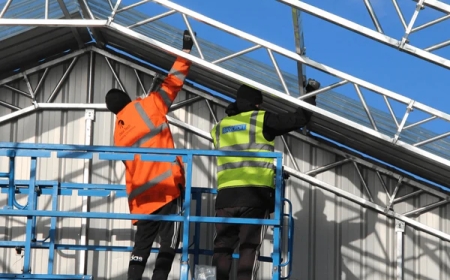How Does Firebox Repair Protect Against Chimney Fires
Firebox repair restores damaged bricks and mortar, ensuring your fireplace stays safe, efficient, and ready for reliable use year-round.

Picture this: its a chilly evening, and your fireplace is aglow, filling the room with cozy warmth. Its a scene most homeowners treasure. But did you know that a hidden danger could be lurking inside your fireplace? Thefirebox, the inner chamber where the fire burns, often takes the most beating from heat and flames. Over time, cracks and gaps can appear in the firebox, creating an easy path for heat or embers to escape toward the chimney structure. Thats wherefirebox repaircomes in, playing a crucial role in protecting your home from the real risk of chimney fires.Firebox repairmight seem small, but its actually one of the most important steps in keeping your hearth safe.
Why Is the Firebox So Important?
Lets break it down. The firebox isnt just another part of your fireplace; its the first line of defense between the intense heat of your fire and the rest of your home. When you light a fire, the firebox contains the flames and keeps them from reaching the wooden framing or walls that surround your chimney. If the firebox is cracked or damaged, the heat can sneak through those flaws, raising the temperature of nearby materials to dangerous levels.
Creaky or crumbling fireboxes dont just look badthey create a direct path for stray sparks or even hot gases to reach places theyre never supposed to go. This is one of the most commonchimney fire hazardsthat experts warn about. Even small cracks can cause big problems. Thats why staying on top of firebox maintenance isnt just about looks; its a real safety issue.
How Does Firebox Repair Stop Chimney Fires?
So, what doesfirebox repairactually do to protect your home? Imagine patching up a leaky boat. Even a tiny hole can let water in, but sealing it up keeps everything dry. Its the same idea here. Sealing cracks and fixing damaged bricks or mortar in the firebox blocks hot embers and gases from escaping into the chimneys hidden spaces, where they might ignite built-up creosote or even wood framing.
Creosote is a sticky, flammable substance that builds up inside chimneys after burning wood. If heat or sparks reach this material through a damaged firebox, it can catch fire in a flash. Thats why fixing the firebox is just as important as cleaning your chimney. In fact, studies show that many chimney fires start because of neglected firebox issues, not just dirty flues.
"A well-maintained firebox is like a firewall for your homeit keeps the heat and flames where they belong, and gives peace of mind every time you light a fire."
When you repair the firebox, youre basically restoring its ability to do its job: keep the fire contained and protect everything around it. This stops the chain reaction that leads to dangerous chimney fires.
Firebox Repair: Whats Involved?
If youre wondering what actually happens during afirebox repair, its a bit like giving your fireplace a facelift. Professionals will inspect the firebox for any worn-out bricks, crumbling mortar, or visible gaps. Sometimes, just the joints need to be refilled with special heat-resistant mortar (a process called repointing). Other times, some bricks might need replacing altogether, especially if theyre cracked or spalling.
Heres a handy table that shows whats checked during a typical firebox repair and why it matters:
| Firebox Component | Possible Issue | Why It's a Risk | Repair Solution |
|---|---|---|---|
| Bricks | Cracks, chips, spalling | Allows heat/embers to escape | Replace damaged bricks |
| Mortar Joints | Gaps, crumbling, missing mortar | Weakens firebox structure | Repoint with fire-resistant mortar |
| Firebox Floor | Worn or uneven surface | Hot spots, increased wear | Level or replace floor bricks |
| Firebox Walls | Discoloration, bulging, cracks | Signals heat damage | Repair or rebuild affected areas |
The key is using the right materials. Standard mortar and bricks cant handle the intense heat of fireplace fires. Thats why professionals use fireclay bricks and special refractory mortara little detail that makes all the difference in fire safety.
Why Routine Firebox Repair Matters More Than You Think
Many folks think, If it looks okay, it must be fine. But damage inside the firebox can be sneaky. Tiny cracks might not be obvious at first, but they can quickly become gateways for fire hazards. Regular inspections, especially before fireplace season, can catch these problems early.
- Prevents minor damage from getting worsesmall cracks are easier (and cheaper) to fix than major rebuilds.
- Guards against hidden chimney fire risksif you use your fireplace often, creosote and heat damage can add up fast.
- Keeps your fireplace working efficientlya sound firebox means better heat and less smoke in your home.
- Protects your insurance coveragemany home insurance policies require fireplaces to be in good repair.
Making firebox repair a regular part of your home care routine is a small step that pays off big in safety and peace of mind.
Conclusion: Firebox Repair Is Your Chimneys Best Defense
When it comes to preventing chimney fires, theres no room for shortcuts.Firebox repairmight not be the most glamorous home project, but its one of the smartest. By sealing up cracks, replacing worn bricks, and using the right materials, youre creating a strong barrier that keeps fire where it belongs. So next time you enjoy your fireplaces warm glow, youll know youve taken the right steps to keep your homeand everyone in itsafe from chimney fires.
Read More: Bakersfield Chimney Sweep











































